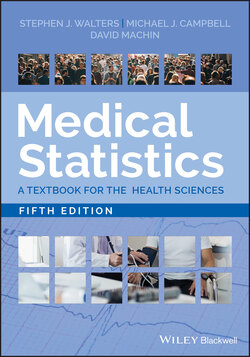Читать книгу Medical Statistics - David Machin - Страница 36
Illustrative Example – Salicylic Acid Plasters for Treatment of Foot Corns
ОглавлениеFarndon et al. (2013) reports a randomised controlled trial that investigated the effectiveness of salicylic acid plasters compared with usual scalpel debridement for treatment of foot corns. As we have already mentioned one categorical variable recorded was the centre where each trial participant was treated. Trial participants were treated at one of seven centres and the corresponding categories as displayed in Table 2.2. The first column shows category (treatment centre) names, whilst the second shows the number of individuals in each category together with its percentage contribution to the total. Since the total sample size is more than 100 we have reported the percentages to one decimal place. Table 2.2 clearly shows that the majority (54.5%) of patients were treated at the ‘Central’ treatment centre.
Table 2.2 Treatment centre for 202 patients with corns who were recruited to a randomised control trial of the effectiveness of salicylic acid plasters compared with ‘usual’ scalpel debridement for the treatment of corns
(Source: data from Farndon et al. 2013).
| Treatment centre | Frequency | Percentage |
|---|---|---|
| Central | 110 | 54.5% |
| Manor | 33 | 16.3% |
| Jordanthorpe | 24 | 11.9% |
| Limbrick | 9 | 4.5% |
| Firth Park | 11 | 5.4% |
| Huddersfield | 9 | 4.5% |
| Darnall | 6 | 3.0% |
| Total | 202 | 100.0 |
In addition to tabulating each variable separately, we might be interested in whether the distribution of patients across each centre is the same for each randomised group. Table 2.3 shows the distribution of the number of patients treated at centre by randomised group; in this case it can be said that treatment centre has been cross‐tabulated with randomised group. Table 2.3 is an example of a contingency table with seven rows (representing treatment centre) and two columns (randomised group). Note that we are interested in the distribution of patients across the seven centres in each randomised group (to see whether or not we have similar numbers of patients randomised to each treatment within each centre), and so the percentages add to 100 down each column, rather than across the rows. In this example since we have 101 and 101 patients in each randomised group the percentages are almost the same as the raw counts. However, for most studies you are unlikely to have exactly 100 participants in each group!
Table 2.3 Cross‐tabulation of treatment centre by randomised group for 202 patients with corns who were recruited to a randomised control trial of the effectiveness of salicylic acid plasters compared with ‘usual’ scalpel debridement for the treatment of corns
(Source: data from Farndon et al. 2013).
| Randomised group | |||
|---|---|---|---|
| Corn plaster | Scalpel | All | |
| n (%) | n (%) | n (%) | |
| Central | 58 (57) | 52 (52) | 110 (54.5) |
| Manor | 13 (13) | 20 (20) | 33 (16.3) |
| Jordanthorpe | 10 (10) | 14 (14) | 24 (11.9) |
| Limbrick | 3 (3) | 6 (6) | 9 (4.5) |
| Firth Park | 7 (7) | 4 (4) | 11 (5.4) |
| Huddersfield | 5 (5) | 4 (4) | 9 (4.5) |
| Darnall | 5 (5) | 1 (1) | 6 (3.0) |
| Total | 101 (100) | 101 (100) | 202 (100) |
